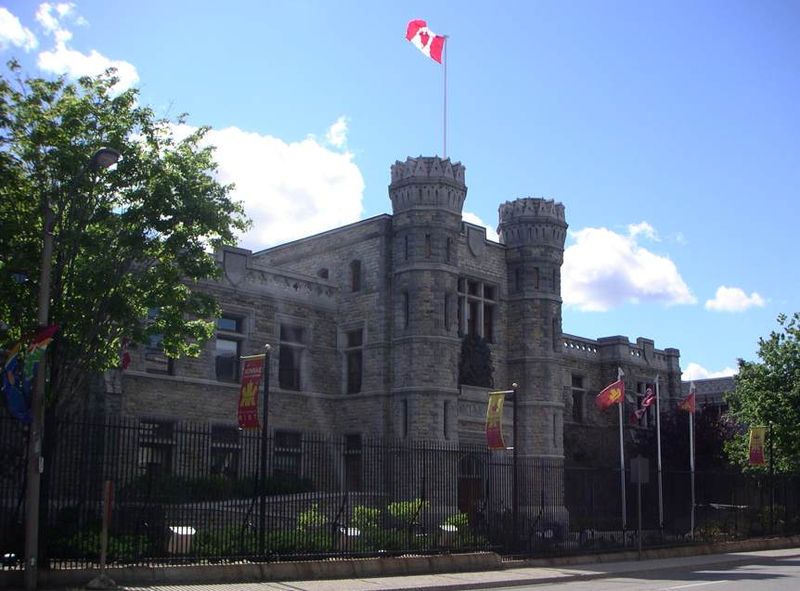Ottawa, Canada's capital city, stands on the south bank of the slow-moving Ottawa River, bordering Gatineau. The gothic-style Parliament Hill buildings are the city's landmark. The bilingual capital is home to several national museums, such as the National Gallery.
Ottawa
Rideau Hall is, since 1867, the official residence in Ottawa of both the Canadian monarch and his or her representative, the Governor General of Canada, and has been described as "Canada's house". Most of Rideau Hall is used for state affairs, only a small part of its area being dedicated to private living quarters. Rideau Hall has also long been a collection point for Canadian art and cabinetry. Today the rooms are furnished both with elements from the history of the residence as well as art and other objects that showcase contemporary Canadian culture, including pieces by the Group of Seven.
The Royal Canadian Mint is a Crown corporation that produces all of Canada's circulation coins and manufactures circulation coins on behalf of other nations. The Ottawa branch began its operations in 1908. In 1979, the building was designated a National Historic Site of Canada, for its representation of the government’s approach to using the Tudor Gothic architectural style to create a distinctive identity in Canada's capital, and of the patriation of control over Canada’s currency from Britain.
Originally built in 1832 in a Neo-classical design, the Notre-Dame Cathedral Basilica is a Roman Catholic minor basilica and a National Historic Site of Canada. It is the oldest and largest church in Ottawa. The steeples are covered with tin, which is typical for French-Canadian churches, and house a peal of bells.
The National Gallery of Canada is one of Canada's premier art galleries. First formed in 1880, it is now housed in a glass and granite building with a notable view of the Canadian Parliament buildings on Parliament Hill. The Gallery has a large and varied collection of paintings, drawings, sculpture and photographs. Although its focus is on Canadian art, it holds works by many noted American and European artists.
Major's Hill Park stands above the Rideau Canal at the point where it enters the Ottawa River. Once known as the "Colonel's Hill", the park now is frequented all year round. It is frequently used as a venue for events, and is central to Ottawa's Canada Day celebrations.
The 202 kilometre long Rideau Canal connects Ottawa to Lake Ontario and the St. Lawrence River. The name Rideau, French for "curtain," is derived from the curtain-like appearance of the Rideau River's twin waterfalls where they join the Ottawa River. The canal was opened in 1832 as a precaution in case of war with the United States. It remains in use today primarily for pleasure boating, with most of its original structures intact. It is the oldest continuously operated canal system in North America, and it is registered as a UNESCO World Heritage Site.
Gatineau, Ottawa
The Canadian Museum of History is Canada's national museum of human history. Its permanent galleries explore Canada's 20,000 years of human history and a program of special exhibitions expands on Canadian themes and explore other cultures and civilizations, past and present.
Originally built in 1827, the Byward Market building and area include open-air stalls offering fresh produce and flowers, eating places, bars, nightclubs, restaurants and boutiques. Traditionally, the ByWard Market area has been a focal point for Ottawa's French and Irish communities. It has also constantly been an area of fluid change, adapting to the increasingly cosmopolitan nature of downtown Ottawa, as well as trends in Canadian society as a whole.
The National War Memorial is a tall, granite memorial arch with accreted bronze sculptures first dedicated by King George VI in 1939. It is the focal point of Confederation Square. Originally built to commemorate the Canadians who died in the First World War, it was in 1982 rededicated to also include those killed in the Second World War and Korean War and again in 2014 to add the dead from the Second Boer War and War in Afghanistan, as well as all Canadians killed in all conflicts past and future.
Parliament Hill is an area of Crown land. Its Gothic revival suite of buildings is the home of the Parliament of Canada and has architectural elements of national symbolic importance. Originally the site of a military base in the 18th and early 19th centuries, development of the area into a governmental precinct began in 1859, after Queen Victoria chose Ottawa as the capital of the Province of Canada.
Originally established in 1880 as a collection of military artifacts, The Canadian War Museum is Canada's national museum of military history. It includes major permanent exhibitions on wars that have been fought on Canadian soil, the total wars of the twentieth century, the Cold War and peace support operations abroad, and Canada's history of honouring and remembrance.
























